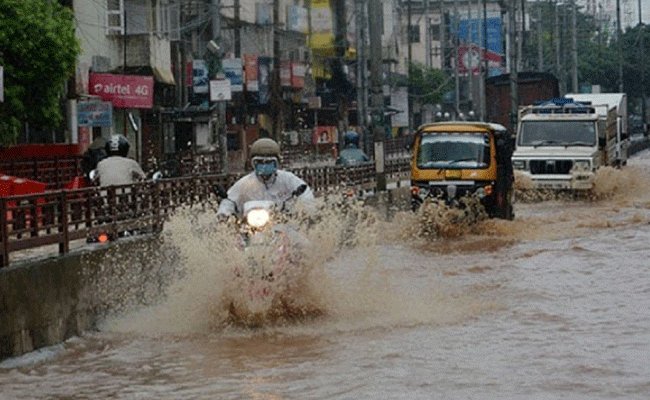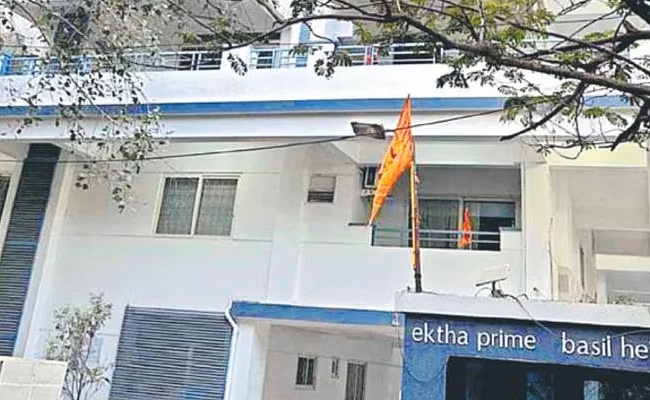
The devastation caused by torrential rains and flash floods in and around Hyderabad this week is another grim reminder of the havoc played with the chain of lakes and storm water drains that were working as a natural flood control system.
This is not the first time the city has witnessed flooding but every time in the recent period, it faced nature's fury, it failed to learn a lesson.
Flooding of roads and inundation of low-lying areas are a common sight in the city whenever it rains heavily. Every time it is brushed aside either as a natural occurrence or inevitable consequence of the rapid development the tech hub is witnessing.
Whenever the city faced flash floods, those in power form committees comprising officials and experts to suggest measures to prevent recurrence. However, reports of these panels, containing almost similar suggestions, are gathering dust.
The extremely heavy rainfall of October 13 triggered a deluge in not just the outskirts but also in the heart of the city. More than 30 people lost their lives and about 2,000 colonies were inundated.
The last time the city had witnessed such massive floods was some 20 years ago. Rainfall of 24.5 cm on August 24, 2000 had caused the deluge.
As the city has expanded by leaps and bounds to become Greater Hyderabad, the rainfall at some Automatic Weather Stations (AWS) installed by the Telangana State Development Planning Society was much higher than 24.5 cm. The AWS at Hayathnagar, for instance, recorded over 29 cm rainfall in 24 hours ending 5 a.m. on October 14.
India Meteorological Department (IMD), however, maintained that the city recorded an average 19.2 cm rainfall. Irrespective of the rainfall amount, the scale of flooding and devastation caused by the latest flooding is unprecedented.
Many of the colonies submerged had either come up on lake beds or close to the lakes. Heavy rainfall led to breach and overflow of the lakes, which shrunk in size over the last 2-3 due to encroachments and construction activity.
Appa cheruvu, for instance, was spread over six acres. Now the lake has shrunk to two acres. Its embankment collapsed following heavy rains of October 13 and caused massive flooding in Gaganpahad area, inundating houses and the Hyderabad-Bengaluru highway.
Historians say Hyderabad's founder Muhammad Quli Sutb Shah and subsequent Qutb Shahi and Asaf Jahi rulers with their foresight had developed and promoted a system to prevent flooding even in the highest rainfall.
The system comprised a chain of lakes, channels connecting lakes to the river, open spaces and swamp areas to suck in rain water and storm water drains.
The city was founded on the banks of Musi river, which was the lifeline of the city. After devastating floods in Musi killed thousands of people in 1908, the government of then Nizam built new reservoirs upstream and developed a new drainage system to prevent recurrence of floods.
The water bodies, channels and storm water drains, popularly known as nalas, were further improved.
"The city had a very good drainage system. Whenever it used to rain, the inflow and outflow channels drain down north and south basins into Musi river. Since those channels have been destroyed, water can't drain into the river. So water is there everywhere," explained Lubna Sarwat, an activist fighting for preservation of lakes.
She pointed out that lakes supposed to hold water were severely restricted in terms of both surface area and holding capacity due to both official and private encroachments.
"Dumping of waste including construction material has further curtailed the holding capacity. Since the lakes can no longer hold water, it is on roads and colonies," said Sarwat, who earlier worked as convenor of Save Our Urban Lakes.
According to the Forum For A Better Hyderabad, a group comprising environmentally conscious individuals and organisations, the city was home to 3,000 to 7,000 natural and manmade water bodies such as lakes, ponds, tanks and other reservoirs.
Over the years, however, most of these water bodies have disappeared. According to the Forum, studies have suggested that since the 1990s, Hyderabad has lost over 3,000 lakes.
"Even till 1970, we had the balance. Post 1970, there was a frightening imbalance in the planning as people from all over the state started coming to the city. People started moving into the city knowingly or unknowingly and converted water bodies into buildings," says heritage activist P. Anuradha Reddy, who earlier headed Society for Preservation of Environment and Quality of Life (SPEQL).
After the floods of 2000, the then government had constituted a committee to suggest measures to improve nalas. The committee, in its report, identified 28,000 encroachments and estimated that removing them and improving the nala system required Rs 10,000 crore. The report was kept aside as its implementation was perceived impossible.
Another committee for expansion and modernization of nalas was formed in 2007. It gave a report which was similar to the previous panel and met the same fate.
Subsequently, another panel of experts suggested various measures to improve nala and restoration of lakes but its report too is gathering dust.
(Mohammad Shafeeq can be contacted at [email protected])













